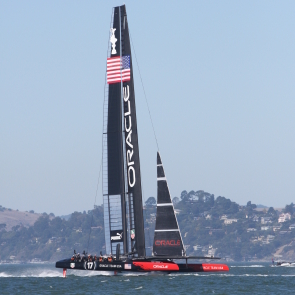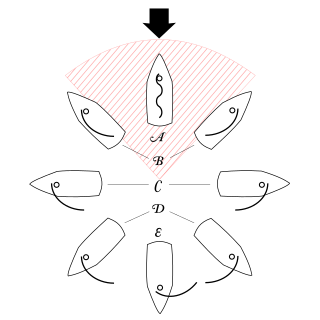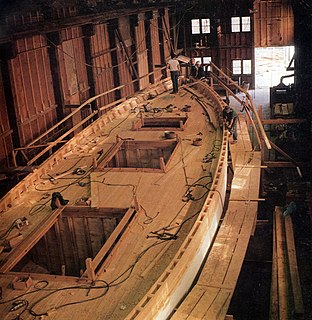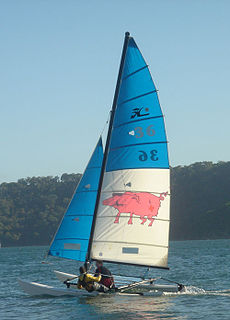This article includes a list of references, related reading or external links, but its sources remain unclear because it lacks inline citations .(April 2018) (Learn how and when to remove this template message) |
The bipod mast is a two-legged mast used originally in Egypt during the 3rd millennium BCE. It can be described as two poles secured together at the top, forming a thin isosceles triangle. It did not appear until the Old Kingdom, third dynasty, and disappeared after the sixth dynasty when the pole mast took over during the Middle Kingdom.

Egypt, officially the Arab Republic of Egypt, is a country spanning the northeast corner of Africa and southwest corner of Asia by a land bridge formed by the Sinai Peninsula. Egypt is a Mediterranean country bordered by the Gaza Strip and Israel to the northeast, the Gulf of Aqaba and the Red Sea to the east, Sudan to the south, and Libya to the west. Across the Gulf of Aqaba lies Jordan, across the Red Sea lies Saudi Arabia, and across the Mediterranean lie Greece, Turkey and Cyprus, although none share a land border with Egypt.

The 3rd millennium BC spanned the years 3000 through 2001 BC. This period of time corresponds to the Early to Middle Bronze Age, characterized by the early empires in the Ancient Near East. In Ancient Egypt, the Early Dynastic Period is followed by the Old Kingdom. In Mesopotamia, the Early Dynastic Period is followed by the Akkadian Empire.
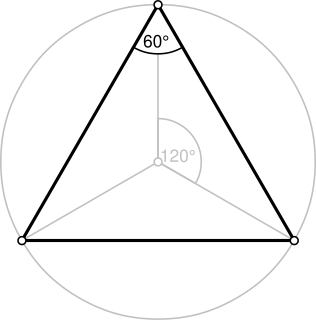
A triangle is a polygon with three edges and three vertices. It is one of the basic shapes in geometry. A triangle with vertices A, B, and C is denoted .
The reason that the bipod mast was used for only a short time is also the reason that it developed in the first place. At the time reed boats were being used to carry goods up and down the Nile. A mast and sail were wanted to make these journeys go more quickly through wind power. The problem was that a pole mast would have to be secured or stepped in the center of the craft, at its weakest point. This would have caused the bottom of the boat to rupture. Because reed materials were not strong enough to support a single pole, the bipod was developed to better distribute the weight. The bipod mast continued to be used even when builders begun using wood to construct boats. It was used both along the Nile and once actual seafaring began. When it was reed materials being used the bipod mast was secured through backstays. Once the builders switched over to wood the two rods were tied to the wood continued to be secured with cables. These bipod masts could easily be stored by folding one side into the other laying it across the ship with its weight evenly distributed on stands also called forked crutches. Thus, the bipod masts were convenient for travel along the Nile. The Nile is easy to travel when heading north, with the current, but when heading south, sailors must use man power and wind power against the current. For this reason the development of the bipod mast was very important. The bipod mast allowed for faster travel south. It is likely that this improved trade because Egyptians did not waste as much time traveling south. Also, the development of the mast was part of the transition into seafaring. In voyaging across the sea a mast and sail are required. So, in conclusion the bipod mast played a major part in ushering in overseas trade.

Reed boats and rafts, along with dugout canoes and other rafts, are among the oldest known types of boats. Often used as traditional fishing boats, they are still used in a few places around the world, though they have generally been replaced with planked boats. Reed boats can be distinguished from reed rafts, since reed boats are usually waterproofed with some form of tar. As well as boats and rafts, small floating islands have also been constructed from reeds.
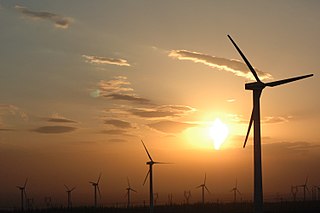
Wind power is the use of air flow through wind turbines to provide the mechanical power to turn electric generators. Wind power, as an alternative to burning fossil fuels, is plentiful, renewable, widely distributed, clean, produces no greenhouse gas emissions during operation, consumes no water, and uses little land. The net effects on the environment are far less problematic than those of fossil fuel sources.

The Nile is a major north-flowing river in northeastern Africa, and is the longest river in the world, though some sources cite the Amazon River as the longest. The Nile, which is about 6,650 km (4,130 mi) long, is an "international" river as its drainage basin covers eleven countries, namely, Tanzania, Uganda, Rwanda, Burundi, the Democratic Republic of the Congo, Kenya, Ethiopia, Eritrea, South Sudan, Republic of the Sudan and Egypt. In particular, the Nile is the primary water source of Egypt and Sudan.

